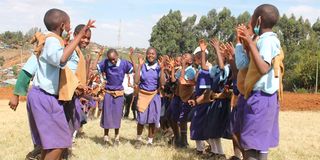CBC discriminates against children from poor homes, pastoralist areas

Grade Five pupils at DEB Primary School in Elburgon, Nakuru County perform a topical and patriotic song during a Music Assessment in the Competency-Based Curriculum on February 9, 2022.
The country is implementing the Competency-Based Curriculum (CBC), which involves the use of learner-centred teaching methods like role-plays, discussion, problem-solving, projects, case study and study visits.
The teacher’s role changes to that of an expert, facilitator, coach and mentor who guides the learning process.
Essentially, CBC requires teachers to be role models, caring and inspiring every learner for the ability to identify and nurture talents to attain their full potential. Pupils are allowed to learn in their own stride and advanced content, demonstrating mastery of desired competencies.
The curriculum generally requires small classes for teachers to give personal attention to every learner, the average classroom size needs to be manageable and not more than 20 learners per teacher.
Unfortunately, in most public schools, especially in arid and semi-arid lands (ASALs), manageable classes are a fantasy due to a lack of infrastructure and pupils learn under a tree. The recent exodus of teachers from northern counties also greatly affected learning.
The pupil-teacher ratio (PTR) was estimated as 22 and 43, respectively, in private and public primary schools. This indicates that, unlike their public school counterparts, private school pupils have the advantage of lean manageable classrooms and, hence, better education outcomes.
Undesirably, 88 per cent of pupils are in public schools, which have bloated class sizes that are cumbersome to manage, hence poor performance.
Therefore, only about 12 per cent of the pupils are favoured by lean, manageable classes with advantageous pupil-teacher-ratio, which can contentedly support CBC.
It is more worrying in the ASALs, where the PTR surges. For instance, in Mandera County, the PTR is 73.5—meaning that, for every primary school teacher there are 78 pupils. How do we expect children from Mandera and other disadvantaged ASAL counties to have equal education outcomes from CBC as those in, say, Nairobi, with a PTR of 1:20?
Adequately resourced
Also, data show many Nairobi schools, especially in the informal settlements, PTR is 1:62. Yet, a pupil in such a school has expectations of his talent and skill being identified equally with one in, say, St Mary School, whose PTR is 1:19. Research shows teachers find it difficult to assess learning progress; this is the fate of more than 80 per cent of the children in CBC.
To realise CBC objectives, schools should be adequately resourced, key stakeholders engaged substantively and teachers reskilled and trained on the new system since they are the heartbeat of the innovation—which was not the case. Instead, CBC was hurriedly implemented without thorough engagement with stakeholders and the framework.
Actually, there is one research report that pointed out that CBC favours students from educated families, where parents are steering learning with adequate materials to support their exposure compatibly. Parents who are more educated are likely to support their children when doing their homework, compared with illiterate ones with no formal education, especially across the poor ASALs.
Parental engagement is another component of CBC. A parent plays an important role in CBC. Hence, a pupil whose parents are illiterate may benefit less from it. We have thousands of children who cannot handle their homework and school activities at home since their parents cannot support them.
CBC is fashioning more disparities in a country where the disparity is already a big problem. Children from marginalised pastoralist communities and humble backgrounds are, unfortunately, disadvantaged. That is due to too many children in one classroom, no access to a computer, low PTR and a high incidence of illiterate parents. Sadly, many proponents of CBC live in urban areas and their children attend private schools.
Although the learning space in public education faces a lot of constrictions with regard to PTRs, gaps and delays in the preparation of learning material with publishing houses have added to the fluidity of the implementation dilemma. Learners are expected to spend two years at an Early Childhood Development and Education (ECDE) centre before joining primary school. ECDEs are ill-prepared for CBC with no framework to guide its implementation and learning materials, including a guiding curriculum.
Mr Adankhalif is a writer and disaster and risk management (DRM) consultant. [email protected].





